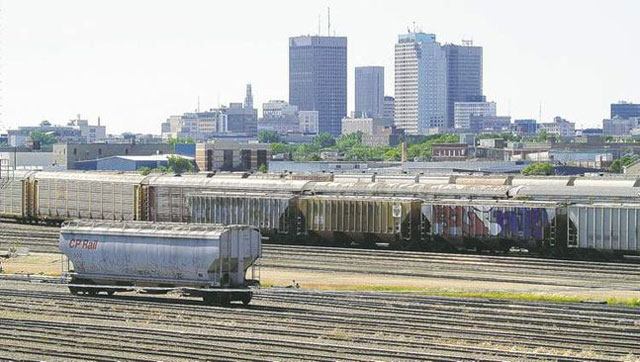
First we need to fix the roads, replace the sewers, fill the potholes. Our property taxes are too high already. We can't afford it. It would cost too much. There are bigger priorities for Winnipeg.
Sentiments like these have generally followed recent public discussion over the potential relocation and redevelopment of the Canadian Pacific Railway yards northwest of the downtown. Instigated by a request to government (by the Social Planning Council of Winnipeg) for a feasibility study, the public debate has met with significant skepticism over the value of what seems to be an unachievable goal, considering the apparent costs and current economic pressures on local government.
It appears to be linear thinking to conclude we cannot afford such a grand dream. If we don't have the money, how can we spend it?
However, stepping back and re-evaluating the root cause of our public fiscal deficit, we might be led to the question: How can we afford not to consider this idea?
Over the last decade, suburban development has lowered Winnipeg's overall population density by pushing the edges of the city outward disproportionately to its population growth. Winnipeg's physical expansion without an equivalent increase in its tax base has stretched the government's ability to pay for services and infrastructure.
Lower population density caused by urban sprawl has resulted in each taxpayer being responsible for a greater proportion of what government provides. With more roads and fewer taxpayers, either taxes must rise, roads must fall into disrepair, or governments must go into debt.
The solution to this incongruent relationship is simply to increase Winnipeg's population at a greater rate than its geographic footprint. An important strategy to achieve this goal would be to maximize the opportunity for large-scale, infill redevelopment on sites that are currently (or were formerly) serving an industrial purpose.
A small-scale example of successful industrial-land redevelopment can be found along the Red River in Winnipeg's Exchange District. When the massive Amy Street Steam Plant and adjacent rail spurs were removed to create Waterfront Drive, it became a catalyst for significant growth in the area, stimulating commercial development and the construction of hundreds of residential units in the area.
Building from this precedent, great potential exists throughout the city to reclaim and transform industrial property into effective infill growth. The Canada Packers site that runs along Marion Street in St. Boniface holds significant opportunity for large-scale mixed-use and residential construction near the city centre. The Forks, of course, is already an example of a thriving rail-yard redevelopment. Adding a large residential component on and adjacent to the site would create a vibrant and dense neighbourhood in the urban core.
The Fort Rouge rail yards along Pembina Highway will also soon see the construction of a major housing development that follows the rapid transit line, serving as a model for infill growth in the future.
Reclaiming each of these industrial properties represents an opportunity to increase Winnipeg's population without expanding its physical size. The most complex, expensive and difficult rail-land reclamation project would be the CP rail yards. If done well, it would also likely be the most impactful. It represents an opportunity to add density to the city while bringing change to a challenged area of Winnipeg.
The typical model for this type of large-scale infill development is to create an entirely new neighbourhood with a unique physical character and often a new population demographic that sits like an island in a sea of older communities.
With names like Calgary's Garrison Woods or Edmonton's Oliver Village, they often function as higher-end, introverted neighbourhoods with new schools and supporting commercial activity incorporated within.
Responding to the unique challenges of the CP land in Winnipeg will require innovative neighbourhood planning, not replication of these previous models. Located in the most economically depressed area of the city, it will be vital that any new development supports the surrounding communities physically, economically and socially.
It will be essential to explore ideas such as the inclusion of areas of light industry and unique commercial activity that attract new investment and create employment opportunities for the surrounding population. It could incorporate elements of affordable student and social housing set within safe, well-integrated park space.
New neighbourhoods could be physically tied to older ones by extending the surrounding street grid pattern through the site and rejecting suburban, cul-de-sac-style planning, which would create an island effect. Instead of building new, introverted retail activity within the development, supporting services could be concentrated on Selkirk Avenue, allowing it to reclaim its historic place as the heart of the North End.
It may be a long time before we are faced with the reality of redeveloping the CP central yards, but public discussion about the potential is important. The opportunity it represents to add significant population growth through infill development and to bring needed social and economic change to a struggling area of our city is one that should be approached carefully and planned for well in advance.
Great cities plan their future. Our rail and industrial lands hold significant potential to redefine Winnipeg's physical character and economic model. With a denser and more financially sustainable city, maybe one day we will be able to fix our roads, sewers and potholes and still be able to afford our bigger dreams.
Brent Bellamy is a senior design architect for Number Ten Architectural Group.
Republished from the Winnipeg Free Press print edition August 20, 2012 B4